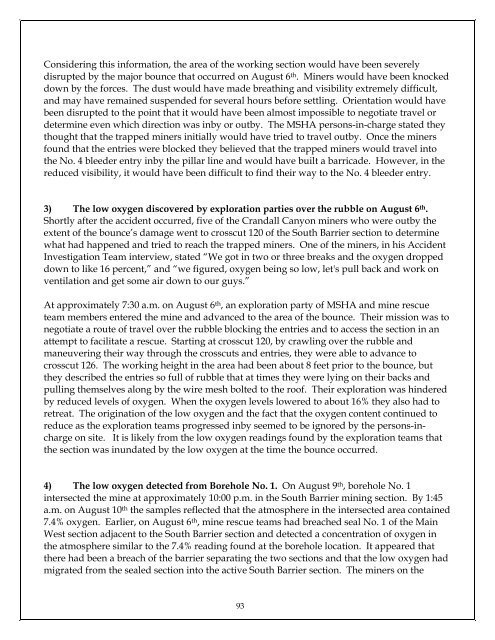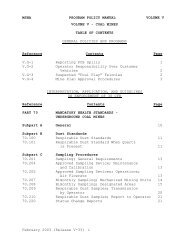Independent Review of MSHA's Actions at Crandall Canyon Mine
Independent Review of MSHA's Actions at Crandall Canyon Mine
Independent Review of MSHA's Actions at Crandall Canyon Mine
You also want an ePaper? Increase the reach of your titles
YUMPU automatically turns print PDFs into web optimized ePapers that Google loves.
Considering this inform<strong>at</strong>ion, the area <strong>of</strong> the working section would have been severely<br />
disrupted by the major bounce th<strong>at</strong> occurred on August 6 th . <strong>Mine</strong>rs would have been knocked<br />
down by the forces. The dust would have made bre<strong>at</strong>hing and visibility extremely difficult,<br />
and may have remained suspended for several hours before settling. Orient<strong>at</strong>ion would have<br />
been disrupted to the point th<strong>at</strong> it would have been almost impossible to negoti<strong>at</strong>e travel or<br />
determine even which direction was inby or outby. The MSHA persons-in-charge st<strong>at</strong>ed they<br />
thought th<strong>at</strong> the trapped miners initially would have tried to travel outby. Once the miners<br />
found th<strong>at</strong> the entries were blocked they believed th<strong>at</strong> the trapped miners would travel into<br />
the No. 4 bleeder entry inby the pillar line and would have built a barricade. However, in the<br />
reduced visibility, it would have been difficult to find their way to the No. 4 bleeder entry.<br />
3) The low oxygen discovered by explor<strong>at</strong>ion parties over the rubble on August 6 th .<br />
Shortly after the accident occurred, five <strong>of</strong> the <strong>Crandall</strong> <strong>Canyon</strong> miners who were outby the<br />
extent <strong>of</strong> the bounce’s damage went to crosscut 120 <strong>of</strong> the South Barrier section to determine<br />
wh<strong>at</strong> had happened and tried to reach the trapped miners. One <strong>of</strong> the miners, in his Accident<br />
Investig<strong>at</strong>ion Team interview, st<strong>at</strong>ed “We got in two or three breaks and the oxygen dropped<br />
down to like 16 percent,” and “we figured, oxygen being so low, let's pull back and work on<br />
ventil<strong>at</strong>ion and get some air down to our guys.”<br />
At approxim<strong>at</strong>ely 7:30 a.m. on August 6 th , an explor<strong>at</strong>ion party <strong>of</strong> MSHA and mine rescue<br />
team members entered the mine and advanced to the area <strong>of</strong> the bounce. Their mission was to<br />
negoti<strong>at</strong>e a route <strong>of</strong> travel over the rubble blocking the entries and to access the section in an<br />
<strong>at</strong>tempt to facilit<strong>at</strong>e a rescue. Starting <strong>at</strong> crosscut 120, by crawling over the rubble and<br />
maneuvering their way through the crosscuts and entries, they were able to advance to<br />
crosscut 126. The working height in the area had been about 8 feet prior to the bounce, but<br />
they described the entries so full <strong>of</strong> rubble th<strong>at</strong> <strong>at</strong> times they were lying on their backs and<br />
pulling themselves along by the wire mesh bolted to the ro<strong>of</strong>. Their explor<strong>at</strong>ion was hindered<br />
by reduced levels <strong>of</strong> oxygen. When the oxygen levels lowered to about 16% they also had to<br />
retre<strong>at</strong>. The origin<strong>at</strong>ion <strong>of</strong> the low oxygen and the fact th<strong>at</strong> the oxygen content continued to<br />
reduce as the explor<strong>at</strong>ion teams progressed inby seemed to be ignored by the persons-incharge<br />
on site. It is likely from the low oxygen readings found by the explor<strong>at</strong>ion teams th<strong>at</strong><br />
the section was inund<strong>at</strong>ed by the low oxygen <strong>at</strong> the time the bounce occurred.<br />
4) The low oxygen detected from Borehole No. 1. On August 9 th , borehole No. 1<br />
intersected the mine <strong>at</strong> approxim<strong>at</strong>ely 10:00 p.m. in the South Barrier mining section. By 1:45<br />
a.m. on August 10 th the samples reflected th<strong>at</strong> the <strong>at</strong>mosphere in the intersected area contained<br />
7.4% oxygen. Earlier, on August 6 th , mine rescue teams had breached seal No. 1 <strong>of</strong> the Main<br />
West section adjacent to the South Barrier section and detected a concentr<strong>at</strong>ion <strong>of</strong> oxygen in<br />
the <strong>at</strong>mosphere similar to the 7.4% reading found <strong>at</strong> the borehole loc<strong>at</strong>ion. It appeared th<strong>at</strong><br />
there had been a breach <strong>of</strong> the barrier separ<strong>at</strong>ing the two sections and th<strong>at</strong> the low oxygen had<br />
migr<strong>at</strong>ed from the sealed section into the active South Barrier section. The miners on the<br />
93

















